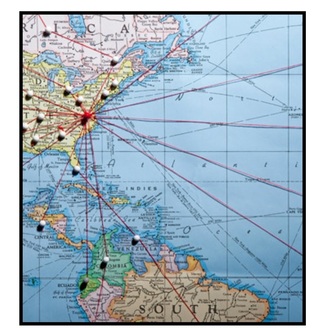|
One my first supervisors asked me to prepare a file folder for him with the details of his upcoming trip. He was ridiculously specific in how he wanted it done. At the time, I thought he was crazy. But the next time I traveled for work, I tried it just to see what was so great about it (if anything).
He wasn’t crazy. I’ve now prepped for my travel this way for over 10 years. Increasingly, I don’t need my printed details as much. There’s any app for everything, including your boarding passes and hotel arrangements. However, out of my last three business trips, my iPhone was stolen once and my new iPhone became a brick on me another time. Really, twice in the last few months, I have been traveling and stranded without a phone. So, let’s say I have a renewed appreciation for having print-outs of your travel arrangements readily accessible. I would like to share how prep your travel details the way my boss taught me years ago. Any standard file folder will work but I tend to like to use red or bright yellow, so that I can see it in amid the chaos of my travel bag. On the tab, put the name of your trip and the dates. If you travel a lot, this will help you stay organized before you go. On the right hand side, you will print out the travel details for your flight. Staple it on the top two corners of the papers. (See photo above.) Then print out your rental car details, hotel details and any other relevant appointment information. Stack them in order with the transport documents on top, followed by accommodations as this is the order that you will need them. Staple them to the left hand side of the open file folder just as you did the flight arrangements on the right hand side. The beauty of this system is not only that you have all the details if your phone fails and you need to reference them (confirmation numbers, loyalty program details, addresses, phone numbers, etc.) but you can grab them quickly and easily. No papers are loose so they won’t fall out on the floor of the airport. And you can choose to peel off the papers you don’t need as you complete flights and check in to the hotel or to keep everything in one place and use these print outs for your expense reports. The folder also becomes a catch all place to store important documents as I’m traveling. I stow baggage claim info and boarding passes for later flights in the folder. If I’m driving, I replace the flight info with Google map directions. (Again, if you phone dies or is stolen, you’ll be glad you did this step.) This method takes 10 extra minutes but it does bring significant benefits while on the road and peace-of-mind when technology lets you down. Try it yourself and let me know if you value it as much as I do.  Deciding where you need to go is the first step to planning your travel. In the absence of wealth screening data or other ratings, I've found it helpful to run a list of every donor who has given $1,000 or more in the last 5 years to my institution. That provides me with a basis for deciding what major metropolitan areas I should visit over the course of the next year. Then you'll need to decide on your travel method. I have used car, plane and train to get where I need to be and each has its own set of pros and cons. You will need to try out different methods and develop your own personal preferences of course. For flights, I start with kayak.com. I like it because I am close to at least 5 possible airports and Kayak gives you great results for looking at nearby airports. This means I can quickly see which airport has the best possible prices for my organization's budget. Then I also check out Southwest too. Southwest airfares won't be in any of the standard databases or searches. Once I have decided on the exact flights I want, I go over to expedia.com because I can pick my exact seat on every flight. This is useful if my family is traveling with me (as they do from time to time) because I go back and purchase the same exact flights with my personal card and select the seats right next to mine. I'm a Hilton Honors member, so I often make that my next stop. (It doesn't matter which loyalty program you join but you will want to join one of them.) I use the Hilton website in close concert with Google Maps because I want to know where my hotel is compared with the home and office locations of most of the donors I need to see. I especially need to know how close everything is so I know whether I require a rental car. I find I'm partial to Embassy Suites, Homewood Suites, and Hampton Inn brands. They have tea always available in the lobby, generous breakfast and most have laundry on site (a must if you ever travel with kids). For rental cars, I like priceline. I try to avoid doing rental cars whenever I can use public transport and/or taxis to get to my visits. When I must have one, I'm not loyal to any one vendor. Price is the big factor. When I arrive, I make extensive use of Google Maps and also Yelp to find places nearby to eat. To make reservations for donor lunches or dinners, I like Open Table. I also like a little history app called Clio. If I'm ever waiting anywhere, I just pull this up and the app shows me all the historical sites that are nearby. It's a great way to get to know a city even if you are too busy to actually go see much of it. I have a very specific way that I prep documents for my travel too. Check back for that post next week. |
Jessica Cloud, CFREI've been called the Tasmanian Devil of fundraising and I'm here to talk shop with you. Archives
June 2024
Categories
All
|


 RSS Feed
RSS Feed
